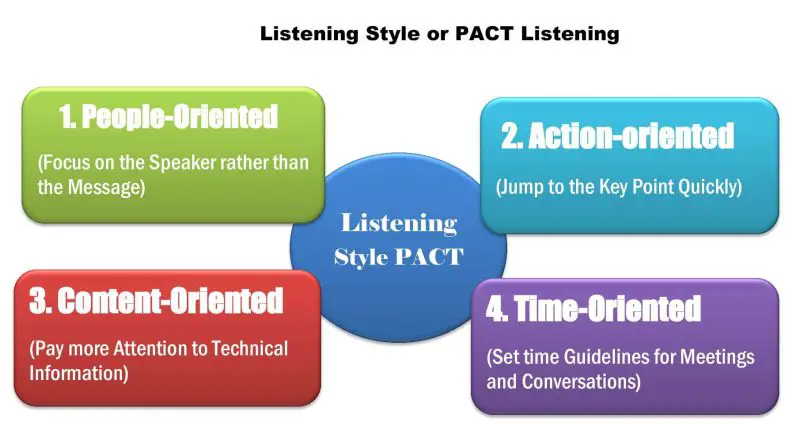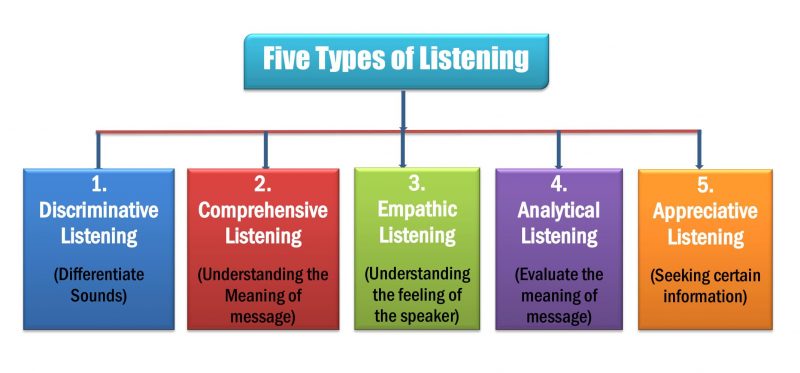Listening Styles. The 4 Listening Styles are People-oriented listening, Content-oriented listening, Action-oriented listening, and Time-oriented listening style.
Listening Styles
Listening is the active and intentional process of hearing something. In contrast, hearing is an unintentional method of perceiving sound. Scholars have identified four types of listening styles: People-oriented listening, Content-oriented listening, Action-oriented listening, and Time-oriented listening. Similarly, the four types of listeners are people-oriented, content-oriented, action-oriented, and time-oriented. The acronym PACT represents these four types of listening styles.
Listening Styles
The four listening styles are:
- People-oriented
- Content-oriented
- Action-oriented
- Time-oriented listening Style
1. People-Oriented Listening Style
In the people-oriented listening style, listeners focus on the feeling of others. They show their feeling and emotion to other people while communicating. People-oriented listeners pay more attention to the speaker than the information or message. Therefore, they are called people-oriented listeners. People-oriented listeners are intended to find the topic of common interest. They are susceptible to others’ emotions and feelings.
These kinds of listeners may also become distracted by others’ problems. They may engage in too many side conversations during meetings.
Example of the people-oriented listeners
For example, an audience is crying for listening to the tragic history of the speaker’s mother, who passed away. Here, the listener has also lost their mother, and they like to talk about the issue of the mother.
Strategies to Communicate with People-Oriented Listeners
Use inspirational examples and appeals; use “we” rather than “I” during communicating with people-oriented listeners.
Key Takeaways
People-oriented listeners focus and pay special attention to the speaker rather than the actual message delivered by the speaker.
2. Action-Oriented Listening Style
In the Action-oriented listening style, listeners look forward to the key point of the speech. They like to listen to the topic sentence and thesis statement of the speech rather than the details. Action-oriented listeners are active audiences, and they respond quickly when required. They give clear feedback concerning expectations. They also encourage others to be organized and concise while speaking to others. After all, they are not interested in the relational communication dimension.
Example of the Action-oriented listeners
A speaker is delivering his speech about the negative impact of social media. A listener asked the speaker if they would like to tell how to prevent the adverse effects of social media. He is an example of an action-oriented listener who finds the critical point of the speech.
Strategies to Communicate with Action-Oriented Listeners
Deliver your speech in an organized way—outline delivering the speech. Keep main points to three or fewer; speak at a rapid but controlled rate.
Key Takeaways
Action-oriented listeners pay particular attention to the critical points of the speech.
3. Content-Oriented Listening Style
In the content-oriented listening style, listeners evaluate the fact and evidence distributed by the speaker. They like statistical reports, examples, advantages, disadvantages, and challenging information. They pay more attention to technical details rather than general information. Content-oriented listeners prefer to receive complex or challenging information. They are cautious in evaluating information before forming an opinion by asking questions.
Example of content-oriented listeners
For example, an audience requests the speaker to show a statistical report on the negative impact of social media. When the speaker showed a statistic report, he was verifying the report with Google scholar.
Strategies for Communicating with content-oriented Listeners
Provide authentically verified information. Use two-sided arguments when possible.
Key Takeaways
Content-oriented listeners pay particular attention to the credibility and authenticity of a speaker’s message.
4. Time-Oriented Listening Style
In the time-oriented listening style, listeners pay attention to the time of the speech delivered by the speaker. This type of listener does not like to spend time on anything. They want to utilize their time properly for their well-being.
People demonstrate as time-oriented listeners when they let others know how much time they have to listen or tell others how long they have to meet. These types of listeners always prefer concise information.
Example of time-oriented listeners
An audience asks the program management how much time it may take to complete the program. He also mentioned that he would join the program if it gets completed within 1 hour.
Strategies for Communicating with Time-Oriented Listeners
Manage and save time, Set time guidelines for meetings and conversations, Encourage wordy speakers, and give cues to others when time is wasted.
Key Takeaways
Time-oriented listeners pay special attention to concise messages. They prefer and accept brief messages rather than detailed information to reduce the attention period.
Conclusion
In conclusion, the four listening styles are people-oriented, content-oriented, action-oriented, and time-oriented listening style.
Difference Between Styles of Listening and Types of Listening
Styles of Listening
For example, the four types of listening styles are People-oriented, Content-oriented, Action-oriented, and Time-oriented.
Types of Listening
For example, the five types of listening are Discriminative, Comprehensive, Empathic, Analytical, and Appreciative.

